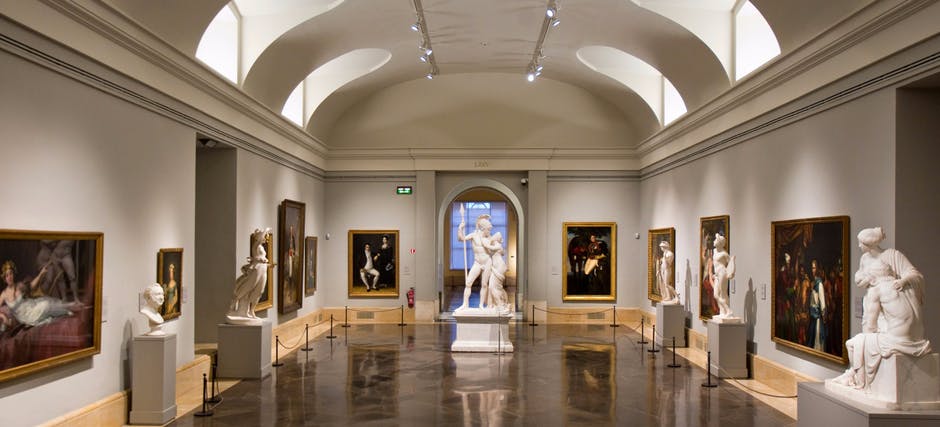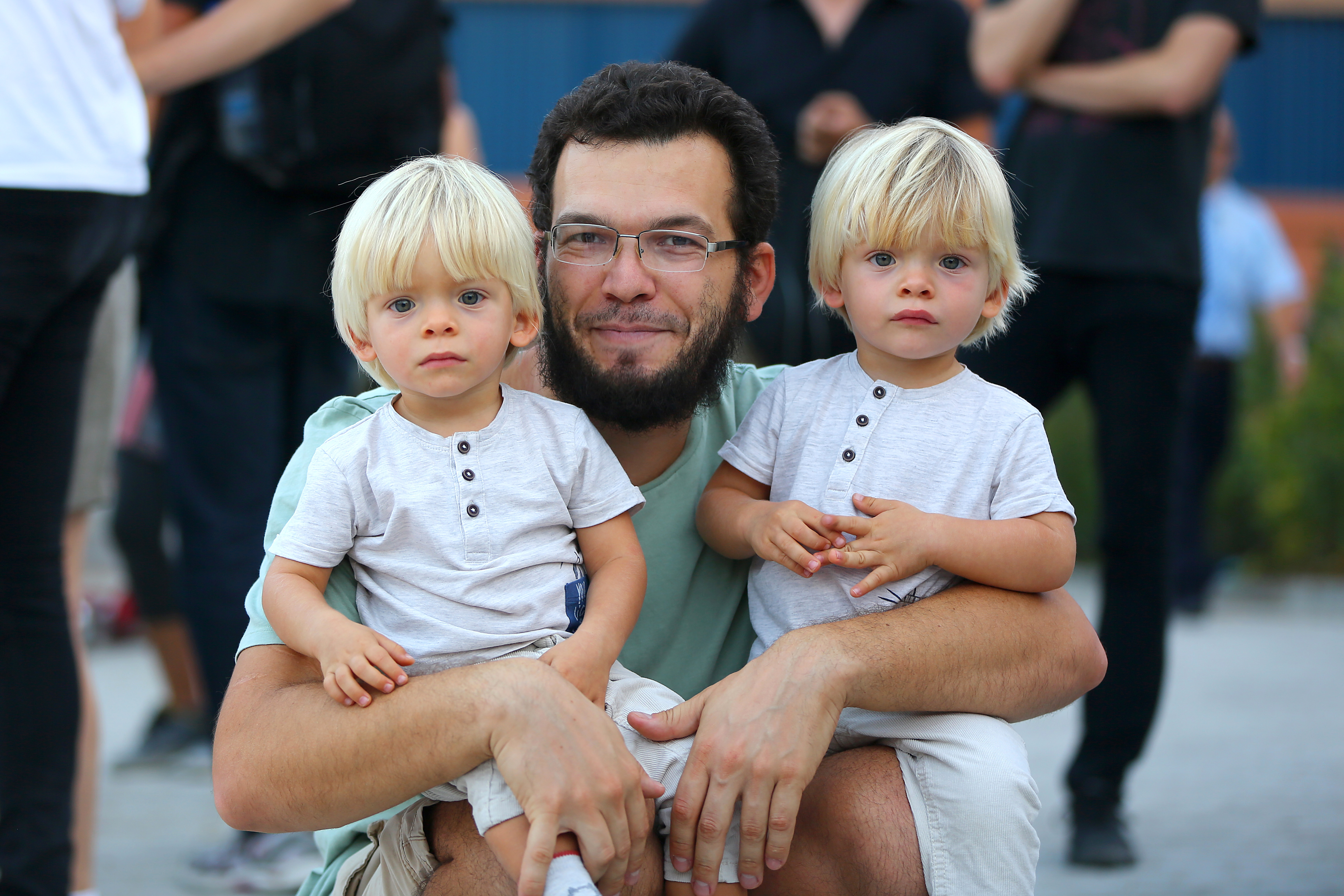Golden Triangle of Art
Planning our trip to Madrid, we surely added the visit to the Golden Triangle of Art – a complex of three art museums located on the Paseo del Prado – to the list.

The Prado Museum is one of the most famous places in the capital. It has a collection of 8,000 paintings and several hundred sculptures including the works by Velázquez, El Greco, Rubens, Goya, and other renowned artists.

When entering the museum, we were given a plan with all major masterpieces marked, but even having it, it’s easy to lose your bearings here. The building is large and has lots of halls. But we had enough time to study the exhibits as we visited the museum alone, without the boys. They got tired of new information quickly and couldn’t concentrate on anything for more than an hour.
The Thyssen-Bornemisza Museum offers its visitors a huge collection of paintings by Impressionists and Post-Impressionists such as Renoir, Cézanne, Degas, and van Gogh.

As for the Reina Sofía Museum, it has one of the largest collections of the 20th-century paintings in Europe including the works by Picasso, González, Dalí, Miró, and Ribera.
Buen Retiro Park and Palacio de Cristal
Madrid became the first city with no beaches and sea for our boys. We managed to find a nice alternative, though, and spent our free time in parks that the capital of Spain is rich in. All parks and green spaces are highly functional – people have a rest here, hide from the sun in the shade of trees, do sports, have lunch, and read sitting right on fluffy green lawns.
The Buen Retiro Park (or simply El Retiro) located in the central part of the city is one of the most famous parks in the capital. In 1561, a royal residence was built here. Shortly after that, a garden was laid out around it, which was used for prayers and retreat by royals (‘buen retiro’ literally means ‘pleasant retreat’). The park had gradually been enlarged, and, by the mid-17th century, it turned into a major venue for organizing the royal family’s events and entertainments.

The Gate of Philip IV brings visitors to the Parterre, the most exquisite part of the park arranged in the French manner. The alleys laid between geometrically shaped flowerbeds lead to a large rectangular lake.

In the summertime, tourists and local citizens enjoy spending time by the water, boating, and having picnics. There were entertainers dressed as fairy tale characters and animals working around the pond. Our boys were really thrilled about them. In the evening, Madrilenian youth gather around the Monument to Alfonso XII.

The Palacio de Cristal, an elegant building from glass and metal, is situated by another small pond. It is currently used for art exhibitions. The pond is inhabited by ducks, geese, and gorgeous swans. Almost tame birds came to us fearlessly counting on getting something tasty.

Going farther from the centre of the park, you see how broad alleys are turning into narrow paths and neatly chipped cypresses and strawberry trees get replaced by wild woods.
We used to walk in the remote areas of the park quite often, while Robert and Michael Jr were collecting chestnuts and removing their spiny peel with interest.
Real Jardín Botánico de Madrid
The Retiro Park adjoins a botanical garden where over 90,000 plants grow.
You can admire a huge rosery here, stroll along the olive alley, visit a fruit garden and see how fruits ripen, look at the collection of cacti, and walk along the plots with herbs. Thanks to the elegant layout and no barriers, the visit to the botanical garden turns into a pleasant walk with children.
Lope de Vega House Museum

The Lope de Vega Museum is definitely worth dropping into when you are walking in the centre. The famous Spanish writer used to live in the traditional Madrilenian house from 1610 to 1635.

We were impressed by the writer’s room fully recreated and containing the 17th-century furniture and his personal things. However, other exhibits were also interesting to look at. The kitchenware, tableware, old furniture, toiletries helped us imagine what the everyday life of that time was like.
Some items may seem strange to modern people. For instance, we were amazed to see a collection of charms in a cradle. In the 17th century, they were considered to be the most effective remedies for diseases. If the baby had a fever, one amulet was used. If it suffered from bellyache, another one was used. No wonder the mortality rate was so high then.
Goya’s Pantheon

The Royal Chapel of St. Anthony of La Florida is a place that’s certainly worth visiting. A small unremarkable church is a true masterpiece inside as its cupola is covered in Francisco de Goya’s frescoes.

When frescoing the dome, the artist used the optical illusion technique. Some of the people pictured seem to look down on the church visitors leaning their elbows on the rails nonchalantly. The fresco looks dimensional and very realistic. At first glance, we even thought that the chapel had a second floor. There are mirrors in the building which let visitors have a better look at the paintings by the genius Spanish artist.
Street Musicians, Cultural Life, and Madrilenians’ Leisure
By the evening, Madrid gets alive as its citizens usually have a late dinner, so all fun begins after work. And it’s not only about hanging out at cafes. Cheerful shows are organized in almost every square and park. There are entertainments for every taste and age: dancers, “live statues”, street athletes, puppet shows.
Improvisational concerts spontaneously starting here and there are worthy of a special mention. We managed to visit several ones within an evening. The babies enjoyed the performances as much as we did. After a month in Madrid, Robert and Michael Jr learned the names of musical instruments and knew the way each one sounded.
Madrilenians mostly lead an active life and like spending time in the open air roller-skating, riding a bike, hanging out with friends, and walking around the beautifully illuminated city.
La Latina Neighbourhood
La Latina is one of the oldest districts of Madrid filled with medieval buildings, narrow meandering streets, and cosy squares. In the 16th century, it was a trade centre where merchants from all over the country came to. The craftsmen whose services were used even by monarchs used to live and work here.

Trade is still an important part of the neighbourhood. El Rastro, the largest flea market in Madrid, works here on Sundays. You can find all sorts of things here – from souvenirs to antiques and matador costumes.
Walking in the neighbourhood, you should definitely visit the secluded Plaza de la Paja and drop into the Capilla del Obispo de Madrid. It’s a small Gothic chapel built in the 16th century.

It looks very plain from the outside, but you can admire the skilfully carved stone bas-relief and the amazing Plateresque altar made by Francisco Giralte.











Leave A Comment